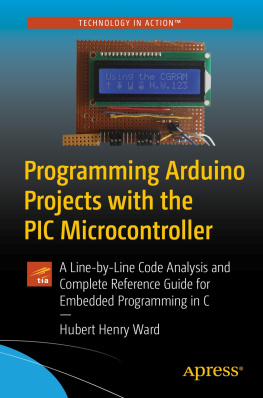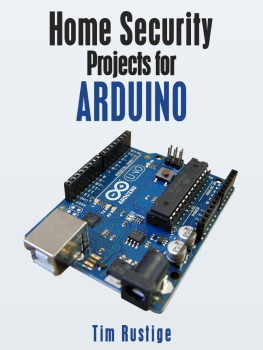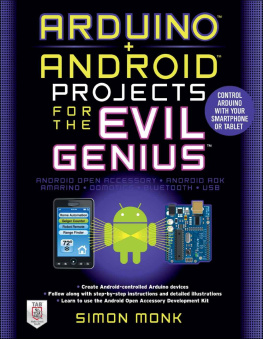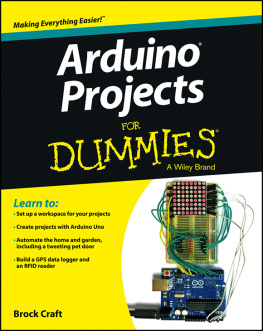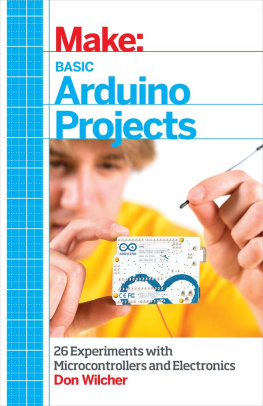Copyright 2015 by McGraw-Hill Education. All rights reserved. Except as permitted under the United States Copyright Act of 1976, no part of this publication may be reproduced or distributed in any form or by any means, or stored in a database or retrieval system, without the prior written permission of the publisher.
ISBN: 978-0-07-183406-3
MHID: 0-07-183406-0
The material in this eBook also appears in the print version of this title: ISBN: 978-0-07-183405-6, MHID: 0-07-183405-2.
eBook conversion by codeMantra
Version 1.0
All trademarks are trademarks of their respective owners. Rather than put a trademark symbol after every occurrence of a trademarked name, we use names in an editorial fashion only, and to the benefit of the trademark owner, with no intention of infringement of the trademark. Where such designations appear in this book, they have been printed with initial caps.
McGraw-Hill Education eBooks are available at special quantity discounts to use as premiums and sales promotions, or for use in corporate training programs. To contact a representative please visit the Contact Us page at www.mhprofessional.com.
The Arduino name and logo and the graphics design of its boards are a protected trademark of Arduino and its partners.
McGraw-Hill Education, the McGraw-Hill Education logo, TAB, and related trade dress are trademarks or registered trademarks of McGraw-Hill Education and/or its affiliates in the United States and other countries and may not be used without written permission. All other trademarks are the property of their respective owners. McGraw-Hill Education is not associated with any product or vendor mentioned in this book.
Information contained in this work has been obtained by McGraw-Hill Education from sources believed to be reliable. However, neither McGraw-Hill Education nor its authors guarantee the accuracy or completeness of any information published herein, and neither McGraw-Hill Education nor its authors shall be responsible for any errors, omissions, or damages arising out of use of this information. This work is published with the understanding that McGraw-Hill Education and its authors are supplying information but are not attempting to render engineering or other professional services. If such services are required, the assistance of an appropriate professional should be sought.
TERMS OF USE
This is a copyrighted work and McGraw-Hill Education and its licensors reserve all rights in and to the work. Use of this work is subject to these terms. Except as permitted under the Copyright Act of 1976 and the right to store and retrieve one copy of the work, you may not decompile, disassemble, reverse engineer, reproduce, modify, create derivative works based upon, transmit, distribute, disseminate, sell, publish or sublicense the work or any part of it without McGraw-Hill Educations prior consent. You may use the work for your own noncommercial and personal use; any other use of the work is strictly prohibited. Your right to use the work may be terminated if you fail to comply with these terms.
THE WORK IS PROVIDED AS IS. McGRAW-HILL EDUCATION AND ITS LICENSORS MAKE NO GUARANTEES OR WARRANTIES AS TO THE ACCURACY, ADEQUACY OR COMPLETENESS OF OR RESULTS TO BE OBTAINED FROM USING THE WORK, INCLUDING ANY INFORMATION THAT CAN BE ACCESSED THROUGH THE WORK VIA HYPERLINK OR OTHERWISE, AND EXPRESSLY DISCLAIM ANY WARRANTY, EXPRESS OR IMPLIED, INCLUDING BUT NOT LIMITED TO IMPLIED WARRANTIES OF MERCHANTABILITY OR FITNESS FOR A PARTICULAR PURPOSE. McGraw-Hill Education and its licensors do not warrant or guarantee that the functions contained in the work will meet your requirements or that its operation will be uninterrupted or error free. Neither McGraw-Hill Education nor its licensors shall be liable to you or anyone else for any inaccuracy, error or omission, regardless of cause, in the work or for any damages resulting therefrom. McGraw-Hill Education has no responsibility for the content of any information accessed through the work. Under no circumstances shall McGraw-Hill Education and/or its licensors be liable for any indirect, incidental, special, punitive, consequential or similar damages that result from the use of or inability to use the work, even if any of them has been advised of the possibility of such damages. This limitation of liability shall apply to any claim or cause whatsoever whether such claim or cause arises in contract, tort or otherwise.
Jack Purdum: To Hailey, Spencer, and Liam
Dennis Kidder: To Helen and Bud
About the Authors
Dr. Jack Purdum, W8TEE, has been a licensed ham since 1954 and is the author of 17 programming books. He retired from Purdue Universitys College of Technology where he taught various programming languages.
Dennis Kidder, W6DQ, has been a licensed ham since 1969. He is also an electrical engineer with a distinguished career in major engineering projects throughout the world, working for companies such as Raytheon and Hughes.
Contents
Preface
M icrocontrollers are cropping up everywhere, from the car you drive to the washing machine that makes you look good for work. More importantly, they are showing up in our transceivers, keyers, antenna analyzers, and other devices we use as ham radio operators. This book has two primary objectives: 1) to present some microcontroller-based projects that we hope you will find both interesting and useful, and 2) to show you just how easy it is to use these devices in projects of your own design. As you will soon discover, microcontrollers are pretty easy to use and bring a whole lot to the feature table at an extremely attractive price point.
Why Should I Buy This Book?
First, we think there is a sufficient variety of projects in this book that at least several of them should appeal to you. The projects result in pieces of equipment that are both useful around the shack and inexpensive to build when compared with their commercial counterparts. Not only that, but we are pretty sure that many of you will have an ah-ha moment where you can think of extensions of, or perhaps even new, projects. If so, we hope you will share your ideas on our web site.
Finally, when you finish this book, we feel confident that you will have a better understanding of what microcontrollers are all about and how easy it is to write the software that augments their power.
For all these reasons, we hope you will read the book from start to finish. In that same vein, we assume there is no urgency on your part in reading this book. Take your time and enjoy the trip.
Errata and Help
Dennis, Jack, Beta testers, and scores of editorial people at McGraw-Hill have scoured this book from cover to cover in every attempt to make this book perfect. Alas, despite the best efforts by all of those people, there are bound to be some hiccups along the way. Also, Jack does not profess to be the worlds authority on software development nor does Dennis presume he has cornered the market on brilliant hardware design. As hiccups show up, we will post the required solutions on the Web. McGraw-Hill maintains a web site (www.mhprofessional.com/arduinohamradio) where you can download the code in this book and read about any errors that may crop up. Rather than type in the code from the book, you should download it from the McGraw-Hill web site. That way, you know you have the latest version of the software. Likewise, if you think you have found an error, please visit the web site and post your discovery. We will maintain our own web site too. This web site, www.arduinoforhamradio.com, will serve as a clearing house for project hardware and software enhancements, new ideas and projects, and questions.




